
4.5 Tons of Caviar Exported Last Year
EghtesadOnline: Of the 12 tons of caviar produced in Iran in the year ending March 2021, 4.5 tons worth $6 million were exported, Isa Golshahi, an official with Iran Fisheries Organization, said.
“In addition 3,500 tons of sturgeon meat was produced last year of which 1,000 tons worth $10 million was exported,” he was quoted as saying by IRNA.
Forty-five percent of Iran’s caviar output is exported and rest is used locally as nutritional food and in cosmetics products, the Golshahi said.
He elaborated that almost 65% of Iran’s caviar is purchased by European companies. “Russia is one of the biggest customers of Iran’s sturgeon meat.
“Iran’s caviar and sturgeon fish are also exported to the Persian Gulf littoral states including the UAE, Qatar, Oman and Kuwait as well as Russia, Azerbaijan, Armenia, Malaysia, China and Japan.”
Caspian Sea, in the north of Iran, is the world’s primary and largest habitat of the beluga, the most famous sturgeon species, as well as four other sturgeon species.
However, the deteriorating conditions in the Caspian Sea has long been threatening this fish with extinction. The declining sturgeon population and the ban on fishing have hurt Iran’s caviar export.
Studies show that most of the world’s sturgeon spawn in the rivers flowing into the Caspian Sea. Iran has stringent laws on poaching the fish while authorities have sought to persuade other countries in the region to implement similar regulations to protect the fish.
The long, prehistoric fish, whose glittery, bead-like eggs make the choicest caviar, has been driven to near extinction by overfishing. But now dozens of Iranian producers raise sturgeons legally on fish farms.
“In the last meeting Caspian littoral states decided to extend the ban on fishing sturgeon for commercial purposes until the end of 2021. The decision was made to protect the rare Caspian aquatic creature. We hope to see the ban extended for years to come,” Golshahi said.
The ban has been in place since 2011.
A total of 140,000 tons of seafood worth more than $430 million was exported from Iran to 26 countries in the last calendar year (March 2020-21), according to the head of Iran Fisheries Organization.
“More than 693,000 tons of seafood was harvested from Iran’s water bodies and around 529,000 tons produced in fish farms across the country,” Nabiollah Khounmirzayi was quoted by IRNA as saying.
The official estimated that this year 700,000 tons of seafood will be harvested and 800,000 tons more will be produced in aqua farms.
A total of 146,000 tons of sea food worth $539 million was exported in fiscal 2019-20. Iran is a major seafood producer in the region with trout, caviar and shrimp being the main export.
In the past few years Iran has set up cages for fish farming in the sea as well as water bodies behind dams, and is expanding the business as part of its plans to increase seafood production.
Chaharmahal-Bakhtiari Province in southwest of Iran accounts for 40% of Iran's seafood production. The province has the capacity to produce 240,000 tons of seafood per year.
The biggest seafood production units in the Middle East are in the industrial city of Shahr-e-Kord. Located 97 km of southwest of the central Iranian province of Isfahan, Shahr-e-Kord is the first in Iran in breeding salmon.
According to Golshahi, Iran’s per capita seafood consumption reached 13.3 kilograms in the last Iranian year (March 2020-21), up 3.9% from 12.8 kilograms the year before.


